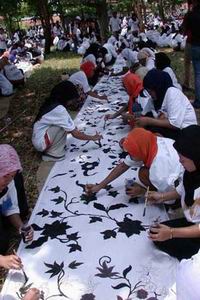World Batik Record: Pekalongan, Central Java
 Pekalongan is one of the main centres for Batik on the island of Java. It is an important textile centre famed for its hand-waxed and stamp-printed batik using distinct motifs (pola). It is the third leading batik producer in Indonesia after the cities of Yogyakarta and Solo.
Pekalongan is one of the main centres for Batik on the island of Java. It is an important textile centre famed for its hand-waxed and stamp-printed batik using distinct motifs (pola). It is the third leading batik producer in Indonesia after the cities of Yogyakarta and Solo.
Now, no longer will the city of Pekalongan bask in the shadows of the other two major batik cities as they have broken a world record for the longest piece of batik painting in the world at the Pekalongan Batik Festival. An exceptional feat as Suherdjoko relates from the city:
Guinness World Records has issued a certificate to the Pekalongan Batik Lovers Association for its feat of breaking the previous record for the largest batik painting in the world, a festival organizer in Pekalongan, Central Java, said.
The head of the Pekalongan Batik Festival organizing committee, Romi Oktabirawa, said Sunday the London-based record-keeping organization had stated that the association was entitled to receive the certificate following its achievement of creating a 1,200-meter long coloured batik painting, which involved 1,000 artisans and was completed in under 24 hours.
The effort was undertaken during the Batik On The Road event on Sept. 16, 2005, as part of the Pekalongan Batik Festival.
“Frankly speaking, we are very proud and thankful over this achievement. We hope the world will always remember Pekalongan for its batik,” said Romi.
The previous world record was set by Sarkasi Said of Singapore in 2003, who created a 100-meter batik painting in nine and a half hours.
Romi said the organizing committee had initially e-mailed the verification division of Guinness World Records.
The organizing committee had sent audio-visual data,
photographs and coverage by major print and electronic media in Indonesia to back the application.
Romi acted as chairman of the committee, M. Ani Sofyan as video cameraman and Arief Wicaksono as photographer. They were supported by Nusyirwan Tirtaamidjaja from Irwan Tirta Batik, multimedia expert Roy Suryo Noto Diprojo and Larasati Suliantoro Sulaiman, a philosophy and aesthetics lecturer from the Gadjah Mada University in Yogyakarta, who signed the agreement with Guinness World Records.
Batik On The Road program officer, Mohamad Ali Djuffry, said the accomplishment was not only accredited to the association, but was also the pride of the people of Pekalongan.
The association’s spokesman, Djudjur T. Susila, said the process of achieving the world record was quite lengthy.
“We received a reply that we’d been shortlisted six months after the feat, and the certificate just arrived in Pekalongan a few days ago,” Djudjur said.
“Compared to other cities with their extravagant promotional campaigns, such as Yogyakarta with its ‘Never Ending Asia’, Surakarta’s ‘The Spirit of Java’, or ‘Enjoy Jakarta’, ours is the cheapest as it was initiated by the local community.”
Pekalongan batik originates from Pekalongan city and Pekalongan regency. Both areas are known as coastal batik centers.
Pekalongan city has 608 batik business ventures employing 5,821 of its 240,000 inhabitants, while Pekalongan regency has 2,000 batik businesses employing around 10,000 of its 850,000 people.
Djudjur said that following the success of the 2005 batik festival, batik lovers in Pekalongan have planned to organize the 2007 Pekalongan Batik Festival under the theme of “World Batik Fiesta”.
“However, this time the Pekalongan municipality seemed to be eager to be involved by taking the initiative to appoint its mayor as chairman and his staff as organizing committee members of the festival,” Djudjur said.
“This is all done for the sake of accomplishing the Trade Ministry’s Indonesia Design Power program, in which Pekalongan city is one of its pilot projects.”
He asserted that some members of the association perceived that the community-based batik festival should not be split between the city and regency. It is inappropriate for bureaucrats to organize the event because they are merely regulators and facilitators, he said.
Djudjur added that artisans had continued creating batik designs and techniques in line with market trends. The processes involved in batik-making are unique, he said, highlighting features such as silkscreen printing and the use of eco-friendly materials.
He acknowledged that chemicals had polluted Pekalongan, citing the often-murky river water there.
“However, we have made efforts to avoid environmental damage by requiring factories to be equipped with waste processing facilities. Besides that, the government has also been selective in issuing business licenses. The Chamber of Commerce is also probing the possibility of working together with its German counterpart in waste management technology,” said Djudjur.
Suherdjoko